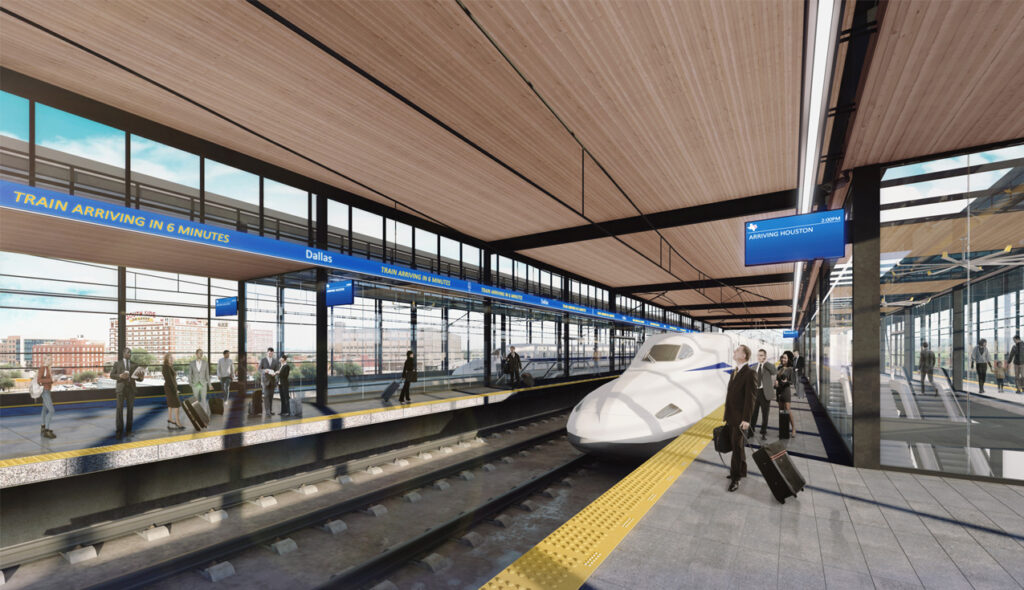All about the community of model railroading and rail enthusiasm
October 20, 2021 / Updated June 26, 2023

Texas high-speed rail investors plan to form an entity to develop train stations in Dallas, Houston and Grimes County near College Station, where the Texas Central Railway’s high-speed rail line terminals will be built.
The Texas High-Speed Rail Station Development Corp. (SDC), independently owned and separate from Texas Central, will build three stations along the planned line from Houston to Dallas.
SDC will undertake planning, design, development, construction, improvement, commissioning, operation, maintenance and funding of the terminals, station sites, platform surfaces and circulation area. The company will engage with governmental agencies and private companies seeking to deliver high-speed rail to Texas.
The company, to be led by investors John Kleinheinz and Jack Matthews, is an offshoot of Cadiz Riverfront Holdings and Cadiz Development Houston, LLC. SDC owns approximately 52 acres south of downtown Dallas, approximately 45 acres in Houston formerly known as Northwest Mall and approximately 59 acres in Grimes County.
The parcels of land include the sites of the future Texas high-speed rail stations and surrounding acreage.
Stations will be located with access to major roadways, connections to public transit options and plenty of on-site parking.
The North Texas passenger station will be in the revitalized Cedars neighborhood of Dallas near the Interstate 30-Interstate 35 interchange.
Brazos Valley Station will be the only stop between Houston and Dallas and serve Bryan-College Station, Huntsville, Madisonville and Navasota. Plans also call for a shuttle service to connect the Texas A&M campus to the Brazos Valley Station.
The Houston station will be near the interchange of US 290 and Interstate 610 in northwest Houston. This is a high-growth area near major employment centers, including the Galleria, Energy Corridor, Medical Center and downtown.
“Our high-speed rail project connecting Dallas and Houston will be as transformational to Texas as DFW Airport was to the region when it was opened in 1973,” Kleinheinz said. “Texas Central will be the blueprint for national high-speed rail, a solution for environmentally efficient transportation. As this first high-speed rail project comes online, Texas is positioned to lead in discussions about a national rail strategy with the local and federal stakeholders.”
SDC’s announcement is the first significant mark of progress for Texas Central Railway in nearly a year.
In September 2020 the Federal Railroad Administration’s Record of Decision gave the environmental go-ahead for the project.
Since 2014, the Texas Central Railway has planned a 90-minute run from Houston to Dallas. The system is based on the Japanese Tokaido Shinkansen high-speed rail system operated by the Central Japan Railway Co. (JRC). Texas Central will use JRC’s Series N700 Supreme rolling stock, the newest generation of Shinkansen high-speed trains; 16-car trainsets operate between Tokyo and Osaka, Japan.
Cost estimate is $24 billion for the project, which will take five or six years to build. The company maintains that it will build the 236-mile line through private funding and without government grants or tax money.
Bank loans are securing about half the money. The other half would come through pending infrastructure bills that would create low-interest, long-term loans.
“Our target has always been loans,” Texas Central President Carlos Aguilar said in a recent WFAA-TV podcast. “It is focused, as I said, on the long-term debt that is available through, for example, the RRIF program out of the U.S. Department of Transportation. And that’s what you need to build large infrastructure.”